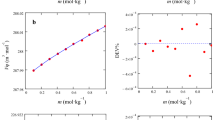Abstract
Previous studies showed that electric fields could change the boiling point and vapor pressure of the vapor–liquid equilibrium (VLE) state of pure substances and mixtures. This is an important feature in controlling the separation of mixtures. In this paper, based on the principle of phase equilibrium, together with the formulas of chemical potential including the effect of electric field and the dielectric pressure, the Raoult’s law was extended to include the effect of electric field to describe VLE of a mixture under an external electric field. The effects of electric field on VLE can be calculated by combining the extended Raoult’s law and the Dalton’s law of partial pressure, and then, the effect of electric field on the relative volatility can also be calculated. Numerical calculations showed that the effects of an electric field on VLE depend on both the magnitude and the direction of the electric field, and the effects become obvious until the field strength is greater than 10\(^{7}\) V/m. When the direction of the electric field is parallel to the gas–liquid interface, the vapor pressure decreases; the equilibrium temperature, the mole fractions of the volatile component, and the relative volatility increase. While, when the direction of the electric field is perpendicular to the gas–liquid interface, the opposite changes in these properties appear. The shifting of the equilibrium curves caused by the electric field indicates that the electric field can cause the vapor–liquid phase transition and change the amount of the phase material.







Similar content being viewed by others
References
Seader, J.D., Henley, E.J., Keith Roper, D.: Separation Process Principles, 3rd edn. Wiley, New York (2011)
Blankenship, K.D., Shah, V.M., Tsouris, C.: Distillation under electric fields. Sep. Sci. Technol. 34(6–7), 1393–1409 (1999)
Tsouris, C., Blankenship, K.D., Dong, J., De Paoli, D.W.: Enhancement of distillation efficiency by application of an electric field. Ind. Eng. Chem. Res. 40, 3843–3847 (2001)
Maximuc, E.P., Bologa, M.K., Gordeev, Y.N.: The influence of electric fields on the intensity of rectification. J. Electrost. 30, 413–422 (1993)
Gao, X., Li, X., Zhang, J., Sun, J., Li, H.: Influence of a microwave irradiation field on vapor–liquid equilibrium. Chem. Eng. Sci. 90, 213–220 (2013)
Katti, P.K., Chaudhri, M.M.: Effect of strong electric fields on the boiling points of some alcohols. Nature 190, 80 (1961)
Anderson, R.A., Sardo, I.S.: Effect of electric and magnetic fields on the boiling point of alcohol. Nature 267, 196 (1962)
Biswas, S., Basu, S.P.: Effect of electric field on the boiling points of liquids. Indian J. Sci. Technol. 14, 165–166 (1976)
Kaminskii, V.A., Pavlenko, A.M., Shaumyan, A.I.: Effect of an electrostatic field on saturated vapor pressure. Elektronnaya Obrabotka Materialov 6, 39–40 (1977)
Richard, K., Lyon: Effect of strong electrical fields on the boiling points of some alcohols. Nature 192, 1285–1286 (1961)
Jacques, R.Q., Jeffrey, A., Gates, R.H.W.: Effect of an electric field on the vapor–liquid equilibrium of a dielectric fluid. J. Phys. Chem. 89, 2647–2648 (1985)
Butt, H.-J., Maria, B., Untch, A.G., Sascha, A.: Electric-field-induced condensation: an extension of the Kelvin equation. Phys. Rev. E 83, 061604 (2011)
Boda, D., Szalai, L., Liszi, J.: Influence of static electric field on the vapour–liquid coexistence of dipolar soft-sphere fluids. J. Chem. Soc. Faraday Trans. 91, 889–894 (1995)
Katie, A.M., Siepmann, J.I.: Effects of an applied electric field on the vapor–liquid equilibria of water, methanol, and dimethyl ether. J. Phys. Chem. B 114, 4261–4270 (2010)
Guangze, H., Jianjia, M.: Extension of Gibbs–Duhem equation including influences of external fields. Contin. Mech. Thermodyn. 30, 817–823 (2018)
Guangze, H., Lin, W.: Phase equilibrium pressure of dielectric system under influence of electrostatic fields. Energy 142, 90–95 (2018)
Han, G., Qiuxia, H.: Effects of electric field on saturated vapor pressure. J. Phys. Chem. C 124(3), 1820–1826 (2020)
Gabor, A., Szalai, I.: Electric field dependence of phase equilibria of binary Stockmayer fluid mixtures. Mol. Phys. 106(8), 1093–1106 (2008)
Atkins, P., de Paula, J.: Physical Chemistry (\(11^{{\rm th}}\)). W H Freeman and Company, New York (2018)
Gorur, G.R.: Dielectrics in Electric Fields. Marcel Dekker Inc., New York (2003)
Haynes, W.M.: CRC Handbook of Chemistry and Physics, 95th edn. CRC Press, Boca Raton (2014)
Landau, L.D., Lifshits, E.M.: Electrodynamics of Continuous Media. Pergamon Press, Oxford (1984)
Bisi, M., Groppi, M., Martalò, G.: The evaporation–condensation problem for a binary mixture of rarefied gases. Contin. Mech. Thermodyn. 32, 1109–1126 (2020)
Carl, L.Y.: The Yaws Handbook of Vapor Pressure Antoine Coefficients. Gulf Professional Publishing, Oxford (2015)
Acknowledgements
The project was supported by the Key Program of National Natural Science Foundation of China (51937005) and the National Natural Science Foundation of China (51576068).
Author information
Authors and Affiliations
Corresponding author
Additional information
Communicated by Andreas Öchsner.
Publisher's Note
Springer Nature remains neutral with regard to jurisdictional claims in published maps and institutional affiliations.
Rights and permissions
Springer Nature or its licensor (e.g. a society or other partner) holds exclusive rights to this article under a publishing agreement with the author(s) or other rightsholder(s); author self-archiving of the accepted manuscript version of this article is solely governed by the terms of such publishing agreement and applicable law.
About this article
Cite this article
Guangze, H., Xinyu, L. Effects of electric field on vapor–liquid equilibrium of binary mixture. Continuum Mech. Thermodyn. 35, 2361–2370 (2023). https://doi.org/10.1007/s00161-023-01253-5
Received:
Accepted:
Published:
Issue Date:
DOI: https://doi.org/10.1007/s00161-023-01253-5




